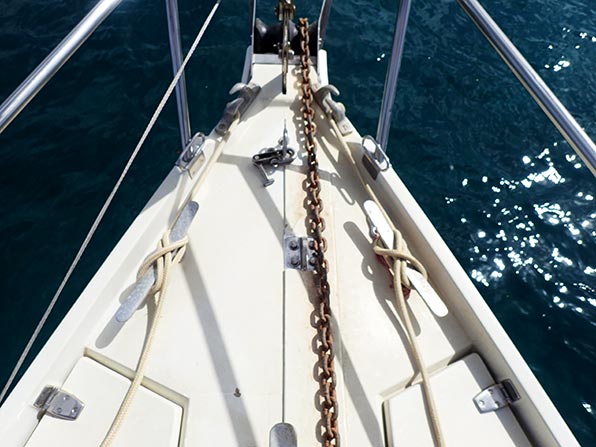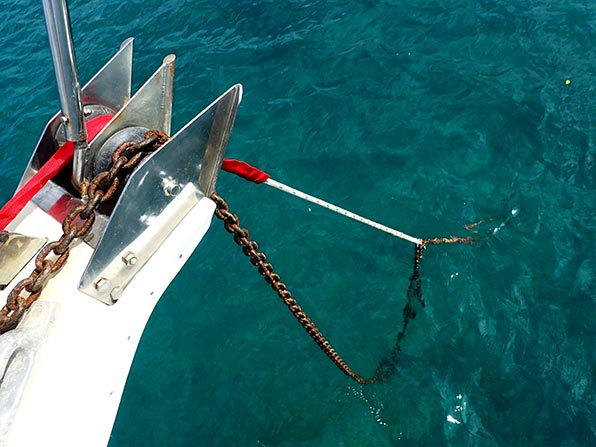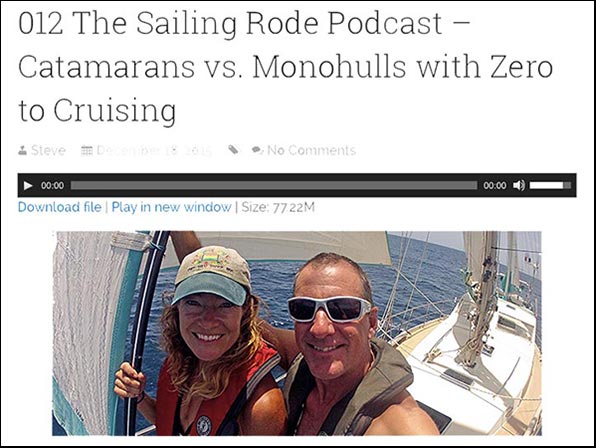The snubber saga continues…
Three weeks ago I mentioned that Rebecca and I were interviewed for The Sailing Rode. I am happy to report that the podcast is now live, and if I do say so myself, it turned out pretty good. Please check it out and let us know your thoughts. And be sure to subscribe to The Sailing Rode too!
In the seemingly never-ending snubber saga…

This twist occurred between the hours of 5:00 PM and 7:00 AM

You can imagine how quickly the line could chafe through if left like this.

Although not a solution to prevent the twist, I rigged some tubular webbing over the line as chafe guard, tie wrapped at each end to hold it stationary.

Unfortunately, the point where the chain crossed was not stationary. You can see here that it is now twisted right at the chain hook. Although this wouldn’t chafe the line, there was no telling what would happen if I left it like this.

By the way, given the short amount of time that the previous snubber lasted, I wasn’t interested in spending the time to splice another eye on the line. You can see that I simply used an enhanced bowline to secure the snubber to the shackle/hook.

Looking for a solution, we dug into our rope locker and found this piece of double braid with a nice eye in the middle. We decided to rig it as a bridle and see how it worked.

While we didn’t see any twist, I wasn’t super happy about how the line would rub on the chain as the boat swung to the side.

Additionally, you can see the damage to the rub rail in this photo. My guess is that this was caused by the boat being secured to a mooring, or rigged with this type of bridle, in strong winds. As the wind gusted, and the boat swung to the side, the line would come in contact with the area that you see damaged.

Unsatisfied with the bridle, we once again dug into the rope locker (we have a lot of misc. lines on the boat) and found a piece of double braid with an eye spliced on one end. We attached the chain hook to it and rigged it as a single-line snubber. I intentionally left the snubber a bit short so that I could monitor the twist, if any (I’m not suspecting any), and the status of that splice.
UPDATE: Twenty four hours later, the new snubber looks fine. The only thing that would make it better is to have it made out of some nice stretchy climbing rope. For the moment though, I’m satisfied.
UPDATE December 18, 2016: Now, one year later, the same snubber is holding fast, and has yet to have any of the twisting issues that the initial snubbers did.



Hi, my friend John who keeps his boat in St Lucia uses two lines, or one line halved with the snubber hook in the middle.. The lines are lead back through the chocks on the port and starboard side and tied to a cleat. Works great for is 48 c&c.
Rgs,
Garry
Ops, should have looked at all the pics…. I see you tried the two line method…
🙂
Have you tried anchoring without a snubber? If you have 5:1 chain out, or more in strong winds, the catenary may well do all that you need.
I have never found it necessary to use a snubber, or a bridle. Use enough chain, secured on a strong cleat, with perhaps a chain hook on a short line to share/take the load.
Maybe you should try it.
I have never seen a snubber in the books about boats going to Patagonia and similarly southerly places
Mike
I like Mike’s idea. If you don’t like loading the chain, how about rigging a much shorter snubber?
Chris.
Just wondering if you had similar problems on ZTC?
As Drew notes below, no.
Mike: Even Starzinger has long Posts on snubbers, in part from his travels in Patagonia.
http://www.bethandevans.com/pdf/snubber.pdf
I have done instrumented testing with and without snubbers. The result depends on water depth and chain size, but typically when the wind got strong (over 25 knots), the no-snubber version would have 2-4 times greater force. This was not visually obvious, so many people miss it… until they drag.
Helen (I too have a PDQ): Catamarans have very wide bridles, so (a) they do not get chain over rope, and (b) 2 leg bridles are not subject to twist since the 2 legs offset each other. I have used a 30strand bridle for years without ever having twist, though I changed to climbing rope a few years ago (even better).
—-
A little bit of trivia for non-climbers. In order to get the high stretch required, the core consists of twisted cords, not braid and not laid rope. However, to prevent twist when a climber is hanging, half of the cords are right hand and half of the cords are left hand. The result is a rope that can take a lot of load cycling without wearing internally, since nothing rubs.
Thanks for the link.
Wouldn’t you love to what how that first picture actually happened? My best guess is that the chain went vertical between surges, as the boat moved forward. But that is just a dumb guess.
Hard to say. I just drove by another boat in our dinghy and saw that the very short three-strand snubber that he had rigged also had the chain looped over the line. Not good.
I enjoyed the podcast.
Thanks, Sal.
I love these types of “technical” (both sailing and equipment) posts Mike. Keep ’em coming please!!
Wilco!
Mike,
Maybe I’m slow, but what do you think made the difference between the snubber in the first photo and the current one? Just the type of rope?
Exactly, Jim. Three-strand line wants to twist, or rather untwist, when loaded. Double braid does not.
Make a quick trip to shore and find your local fire department/bomberos/pompier. Ask them for a length of old fire hose.
There should be PLENTY of old hose in their bay and you could probably score quite a bit. The hose will handle the chafing much better than your webbing.
Offer a donation to the crew in the way of baked goods or towards a cause of the crew’s choosing (most of them put money toward burn victims funds or retirement funds)
Hi Ryan. The fire hose is overkill for the application IMO. As I noted at the bottom of the post, it’s now been one full year of using the exact same setup. There is virtually zero wear on the webbing. It’s only become a bit faded in the sun (the color red is the worst for that). The fire hose is great for storm protection though. We carried a bunch of it on ZTC.